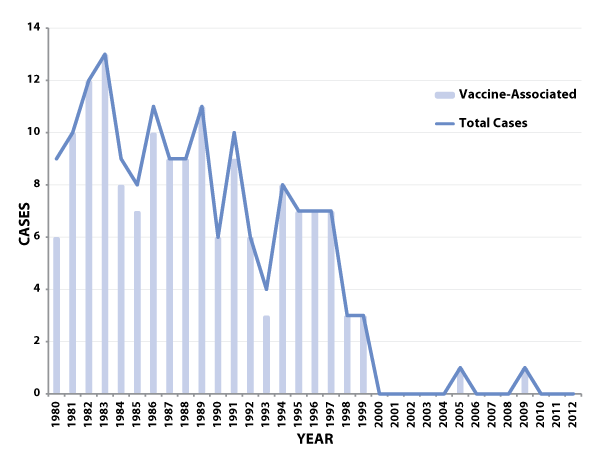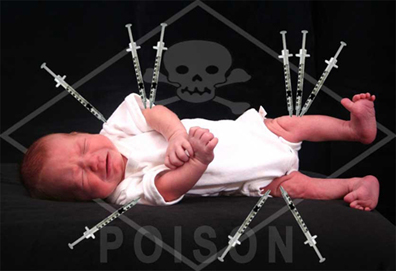Childhood Vaccines that are Unjustifiably Mandated

Below, Meryl Nass, MD,* an internal medicine physician whose expertise in vaccines includes creating a methodology for investigating and distinguishing between natural epidemics and biological warfare events, provides substantive information about several vaccines that are on the Childhood Vaccination Schedule.
Childhood Vaccines that are Unjustifiably Mandated
Meryl Nass, MD February 25, 2019
In 2019, sixteen different vaccines are recommended for all American children by the CDC. The schedule for delivering multiple doses of each, can be found here.
- Three of these are used for diseases have been wiped out, and there is less than a one in 50 million chance that a child in the United States could be exposed to these illnesses.
- The illnesses that have been eliminated in the U.S. are: polio, rubella, and diphtheria.
- Two additional recommended vaccines are for illnesses that are not transmitted between children: tetanus and Hepatitis B. They cannot be spread by casual contact.
- The Meningitis A vaccine program requires one million children to be vaccinated to prevent one single case of the disease.
- Yet most states mandate that children to receive these vaccines in order to attend school. The justification for denying an education to children who do not receive these six vaccines– is the false and medically implausible claim that they would be endangering other children who may be susceptible to the diseases. Why, then are these vaccines required for children ?
Polio: The last polio case in the United States due to “wild type” or natural polio was in 1979. Since then, several cases were brought into the US from outside. The last time this happened was in 1993, according to the CDC. In the past 20 years, the handful of polio cases that occurred in the US have been due to infections from viruses derived from live polio vaccines. As per the CDC Manual for the Surveillance of Vaccine-Preventable Diseases:

In the last 20 years, a handful of people in the US have developed paralytic polio from vaccine-derived viruses.
For this reason, American children have stopped receiving live polio vaccines and now receive a “killed” or inactivated polio vaccine. But if they are not leaving the US, the likelihood of being exposed to polio is virtually nil. Why must they have four doses of polio vaccine, and boosters if they travel to one of the three countries on earth where polio can occur?
Wild-type, natural polio occurred in only three countries in 2016-7, vaccine-strain derived polio cases were identified in 15 countries, according to the WHO. Yet live polio vaccines continue to be used.
Rubella: Seven cases were reported in the US in 2017. According to the CDC, “Today, less than 10 people in the United States are reported as having rubella each year. Since 2012, all rubella cases had evidence that they were infected when they were living or traveling outside the United States.”
Diphtheria: This is the third disease that has been wiped out in the US. “In the past decade, there were less than five cases of diphtheria in the United States reported to CDC.” Yet, U.S. children receive six doses of diphtheria vaccine by the age of 12, as part of the DTaP vaccine [diphtheria, pertussis and tetanus].
Hepatitis B: This is a disease that essentially never occurs in young children, if their parents have transmissible hepatitis B. There were 31 new cases reported in babies under age 2 in 2017 in the US. CDC lists the sources of infection for hepatitis B; they involve sexual activity or blood to blood contact, most commonly from the use of dirty needles:
“Hepatitis B is spread when blood, semen, or other body fluid infected with the Hepatitis B virus enters the body of a person who is not infected. People can become infected with the virus through:
- Birth (a baby whose mother is infected can be infected at or after birth)
- Sharing items such as razors or toothbrushes with an infected person
- Contact with the blood or open sores of an infected person
- Sex with an infected partner
- Sharing needles, syringes, or other drug-injection equipment
- Exposure to blood from needlesticks or other sharp instruments”
Less than 1% of US parents are contagious for hepatitis B, and pregnant women are universally tested for hepatitis B in the United States. Yet all newborns in the United States are given hepatitis B vaccine on the first day of life, regardless of whether their parents are infected or contagious.
- There is simply no reason to give a newborn baby any vaccine on the first day of life, often minutes after birth, and before you know very much about your child. Why subject an unknown and extremely immature immune system to unnecessary toxic substances, which include, in addition to Hepatitis B surface antigen, yeast proteins, aluminum and formaldehyde?
- There is no medical or public health reason to give newborn babies who are at no risk of infection a vaccine on the first day of life.
- To inject a newborn child with substances that cannot help, but certainly may harm them, is public health in reverse.
Tetanus: While tetanus is a very serious neurologic disease caused by bacteria growing in a contaminated wound, it never spreads from person to person. There are about 30 cases of tetanus yearly in the US. Vaccination for tetanus is usually a good idea. However, the plain, single tetanus vaccine (Tetanus Toxoid Adsorbed by Sanofi) was discontinued last year in the US. Tetanus vaccine is now only available coupled to diphtheria vaccine, or to both diphtheria and pertussis vaccines. Why?
Neisseria meningitidis: This is a type of bacteria with at least 12 different serotypes, of which six are known to cause epidemics. Neisseria meningitidis can cause serious cases of meningitis or sepsis. Surprisingly, these bacteria live in the nose or throat of from 1-25% of the population, but the vast majority of people who harbor the bacteria never get sick.
In the US, there is a vaccine for 4 serotypes (A,C,W,Y) and a second vaccine for the B serotype. These vaccines are referred to as Men A and Men B. Only the Men A (A,C,W,Y) vaccine is routinely recommended for children aged 12 and 16 in the US.
Over time, long before there was a childhood meningitis vaccine available, Neisseria meningitidis infections became extremely rare in the US, for reasons that are completely unknown. In 2017, there were only 107 reported cases of meningitis ACWY in all age groups, in the entire United States–of which only eight cases occurred in the target group of 11 through 23 year olds that might have been prevented by the vaccine.
CDC recommends that 8 million children receive this vaccine annually to prevent just eight cases of meningitits. That is, if the vaccine is highly effective. But because there are so few cases, how effective it is in the US population remains unknown.
The recommended Men A vaccine only contains 4 of serotypes, whereas there are at least 12 serotypes of Neisseria meningitidis. Rates of illness from the other serotypes have also dropped dramatically, even though no one is vaccinated against them.
Vaccination does not prevent children from carrying the bacteria in their nose or throat. In fact, several studies have shown that children vaccinated against meningitis have a higher rate of bacterial carriage than non-vaccinated children.
While it is uncertain how useful the Men ACWY vaccine is for children, it is clear that it puts some children at risk of significant harm. The Menactra brand of ACWY vaccine contains diphtheria toxoid (vaccine) and formaldehyde. The Menactra label notes:
“In adolescents 11 through 18 years of age and adults 18 years through 55 years of age, SAEs (serious adverse events) occurred at a rate of 1.0% following Menactra and at a rate of 1.3% following Menomune – A/C/Y/W-135. In adolescents and adults, SAEs occurred at a rate of 1.3% following booster vaccination with Menactra…”
This is what you need to know: a serious adverse event is really very serious. FDA has given the term, Serious Adverse Event a specific definition in relation to the patient’s outcome: Death, a Life-threatening event, Hospitalization (initial or prolonged) Disability or Permanent Damage, Congenital Anomaly/Birth Defect. This is what you can expect to befall 1% of the children who receive this vaccine. For what?
* Dr. Nass is on the board of directors of the Alliance for Human Research Protection.



